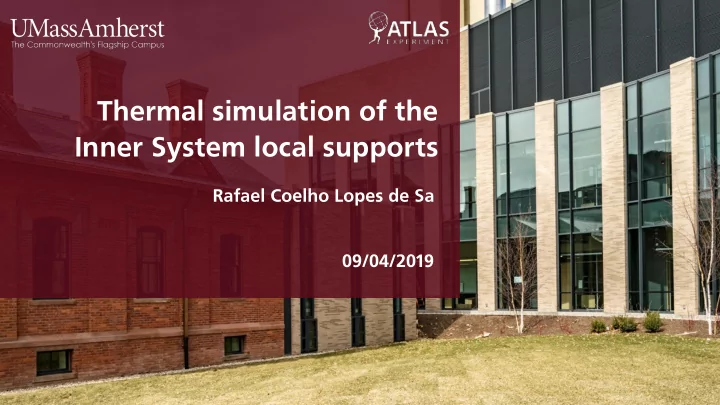

Thermal simulation of the Inner System local supports Rafael Coelho Lopes de Sa 09/04/2019
Introduction max delta T (arb conditions) • Last time we presented a preliminary study of the thermal simulation of the Inner System local supports. R0/1-1 ring sensor max temp 262 • The mesh at the time was done as small as possible, basically 260 limited by the computer where the simulation was being run. 258 256 • A new CAD server with multiple cores was installed at UMass 254 for this simulation, allowing to further reduce the mesh and 252 greatly reducing the time per simulation in AnSys. 250 248 • We improved the mesh to element sizes of 700 μ m for layer 1 0 0.5 1 1.5 2 2.5 and 400 μ m for layer 0. This allows for a more detailed mesh element size meshing of the periphery of the FE chip, for instance. • The result does change significantly from the last presentation. • Maybe even more detailed meshing study is called for. � 2
Reminder • We are following close this presentation: – https://indico.cern.ch/event/834964/contributions/3499224/attachments/ 1881668/3114616/ThermalAnalysis_InputFEA_DAF_VR15.pdf • We will try to provide information following the format suggested in this presentation. • We do not do everything that is in that presentation yet, but we chose to use this simulation to study the design aspects. � 3
Thermal conductivities Thermal Conductivity (W/ Item Material Notes mK) 150 μ m wall thickness Tube Titanium 16.4 1.5mm ID for layer 0 2.0mm ID for layer 1 & CR Tube-foam adhesive Loaded epoxy 4 50 μ m thickness Foam High cond graphite foam 20 Facing Prepreg 600 (in plane), 2.2 (across) 150 μ m thickness 75% coverage, 100 μ m Loading adhesive S4445 1.3 thickness FE chip, sensor Silicon Temperature dependent � 4
Silicon property and module dimensions Layer 0 modules Layer 1 modules Modules taken directly from AT2-IP-EP-0009 v4 � 5
What do we simulate? 5 3D modules (middle triplet) 3+2 3D module single triplet (can’t test failure modes yet) 3+2 quad modules (middle quad) � 6
In more details This has been suppressed Calculated on average with Thome’s model (should be cross checked by differential CoBra simulation) � 7
Average HTC (from Thome’s model) Final Number of Local Number of Length Mass flow HTC (kW/ average modules/ Power (W) ID (mm) vap quality Support units (cm) (g/s) m2K) vapor unit quality Coupled 3 6 62 2.0000 28 3.15 0.26 11.7 0.34 Ring R0 Coupled 4 20 252 2.0000 63 3.15 0.01 14.0 0.26 Ring R1 R0 inter 3 10 104 1.5000 46 1.04 0.01 11.9 0.32 R1 outer 4 20 252 2.0000 63 2.52 0.01 14.0 0.32 L0 stave 3 8 83 1.5000 48 0.83 0.01 10.1 0.32 L1 stave 4 12 152 2.0000 48 1.52 0.01 12.1 0.32 � 8
Sensor dissipation For the simulation we use V=V bias and the local T. t sensor can be read from the previous slides � 9
Heat flux We add another 0.08 W/cm ² for services in layer 1, and 0.1 W/ cm ² for services in layer 0. � 10
Results R0/1-1 R0/1-1 ring Scenarios Bending 1 2 3 4e 4i 5e 5i radius 9.5 263.26 263.27 271.67 273.91 276.22 282.48 285.36 10 255.37 259.95 266.54 270.33 269.32 277.24 276.28 10.5 258.14 262.55 269.02 273.24 270.77 280.07 277.08 11 261.69 265.99 272.45 285.9 281.66 284.26 280.66 minimum 10.3 10.1 10.2 10.0 10.2 10.0 10.2 256.0 260.6 267.2 269.9 267.2 269.9 268.8 DT 17.8 22.5 29.0 31.7 29.0 31.7 30.6 � 11
Graphs Scenarios 290 Max sensor temperature 285 280 275 270 265 260 255 250 9.4 9.6 9.8 10 10.2 10.4 10.6 10.8 11 11.2 1 2 3 4e 4i 5e 5i Poly. (1) Poly. (2) Poly. (3) Poly. (4e) Poly. (4i) Poly. (5e) Poly. (5i) Tube bending radius � 12
Results R0/1-0 R0/1-0 ring Scenarios Bending radius 1 2 4 247.69 251.04 4.5 245.42 248.4 5 250.24 250.26 minimum 4.41 4.54 245.3 248.4 DT 7.2 10.2 � 13
Graphs Max sensor temperature Scenario 252 251 250 249 248 247 246 245 3.5 3.7 3.9 4.1 4.3 4.5 4.7 4.9 5.1 5.3 5.5 1 2 Poly. (1) Poly. (2) Tube bending radius � 14
Results L0 L0 stave Scenarios 1 2 3 4 5 1.32 248.46 252.65 258.48 262.71 267.72 1.06 246.93 250.64 255.81 259.81 264.38 Distance from the edge 0.8 248.34 249.23 253.66 257.39 261.46 with periphery to tube 0.54 250.53 249.02 252.79 256.31 259.89 center (currently 0.8cm) 0.28 254.31 252.19 255.16 259.02 262.43 minimum 1.04 0.76 0.65 0.64 0.59 247.4 249.1 253.3 256.9 260.7 DT 9.2 10.9 15.1 18.8 22.5 � 15
Graphs Scenarios 270 Max sensor temperature 265 260 255 250 245 0 0.2 0.4 0.6 0.8 1 1.2 1.4 1 2 3 4 5 Poly. (1) Poly. (2) Poly. (3) Poly. (4) Poly. (5) Position of the tube wrt to edge with periphery � 16
Still to do • Understand mesh features, specially for rings • Study failure cases for R0/1-0 • Study L1 and R0inter. • Study current densities on sensors from temperature gradient • Study runway using this simulation � 17
The End � 18
Recommend
More recommend